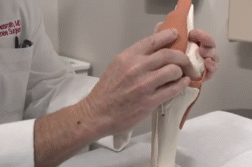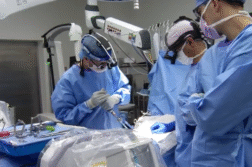CHICAGO, Ill. (Ivanhoe Newswire)—This year, 1.6 million Americans will undergo spine surgery for herniated disks, bone spurs, and even conditions like stenosis. Now, details from one of the few surgeons in the country performing a new ultra- minimally invasive awake spine surgery that could have patients up and walking the same day.
Retiree Joe Deakin is no stranger to back pain, working over 30 years in construction.
“Lot of heavy lifting and climbing, it took a toll on me,” Deakin recalled.
With one spinal fusion and months of recovery already under his belt, Joe knew something was wrong when he felt a pop in his back last October. After an MRI revealed a herniated disk, spine surgery became Joe’s only option. But this time, Dr. Kern Singh offered Joe a new approach, endoscopic spine surgery or ESS.
Unlike hours- long traditional procedures that cut into the center of the back and through muscles, removing full sections of bone, ESS is a 30-minute outpatient procedure that uses a seven-millimeter camera inserted through an incision smaller than the center of a penny.
“And from inside you kind of roto rooter out the bone spurs, the disk bulges, and that way you don’t disrupt any of the muscle, any of the bone, any of the ligaments,” explained Kern Singh, MD, co-director of the Minimally Invasive Spine Institute and professor in the department of orthopedic surgery at Rush University Medical Center.
ESS also has far less risk, as patients are not put under general anesthesia during the procedure.
“Which was kind of weird, normally you go in the operating room and they put you on the table. I went in and they said, ‘alright, climb on the table,” Deakin recalled.
“It’s immediate return to function as they walk out the door about an hour afterward,” Dr. Singh illustrated.
“It’s been wonderful, I mean two days after recovery my wife and I took a walk around the neighborhood,” Deakin shared.
The biggest risk in endoscopic spine surgery is that not enough tissue is taken out during the procedure. This is typically because many surgeons are not yet performing ESS or have very little experience with it. Dr. Singh stresses that patients should seek out surgeons actively practicing ESS on a routine basis to ensure the best outcomes.
Contributors to this news report include: Cyndy McGrath, Executive Producer; Sabrina Broadbent, Field Producer; Roque Correa, Editor.
To receive a free weekly e-mail on Medical Breakthroughs from Ivanhoe, sign up at: http://www.ivanhoe.com/ftk
Sources:
MEDICAL BREAKTHROUGHS
RESEARCH SUMMARY
TOPIC: ESS: THE FUTURE OF SPINE SURGERY!
REPORT: MB #4888
BACKGROUND: Lower back pain is one of the most common issues sending patients to their primary care physicians. However, most back pain resolves on its own or with conservative treatments. Back surgery only becomes an option when other treatments fail, and the pain or numbness is both persistent and debilitating. These symptoms usually occur as the result of herniated disks, overgrowth of bone or disk bulges. Spine surgery is also an approach for conditions like stenosis as well as traumatic injuries. The main forms of traditional spine surgery are diskectomy, laminectomy, fusion, and artificial disk placement. In diskectomy, the herniated portion of a disk is removed to relieve irritation and inflammation. In a laminectomy, the bone overlying the spinal canal is removed to relieve nerve pressure. During a fusion, two or more bones in the spine are permanently fused together relieving pain and adding stability. And implanted artificial disks are a treatment alternative to spinal fusion for painful movement between two vertebrae.
(Source: https://www.mayoclinic.org/diseases-conditions/back-pain/in-depth/back-surgery/art-20048274)
ADVANCES: In contrast to open spine surgery, minimally invasive surgical techniques offer an approach that is faster, safer, and easier to recover from. Traditional open back surgery inflicts a lot of trauma to the muscles and soft tissues in the lower back by cutting through and retracting them to expose the spine. Minimally invasive spine surgery significantly reduces this trauma to the tissue. Minimally invasive approaches also result in better cosmetic outcomes due to the reduced incision size, less total blood loss from surgery, reduced muscle damage, reduced risk of infection and postoperative pain, faster overall recovery and less required rehabilitation, and diminished reliance on pain medications post-op.
NEW TECHNOLOGY: Now, surgeons have developed a technique coined ultra-minimally-invasive spine surgery. Endoscopic spine surgery, also called ESS, is a surgical procedure using micro-sized incisions as small as several millimeters. Endoscopic approaches have been used in other areas of the body such as the gastrointestinal system, but now advances in optics, imaging, and visualizations have made this a viable approach for spine surgery as well. ESS utilizes mostly local anesthesia, involves an incision size of a pen tip with only a single band-aid applied after surgery, and is performed as a same-day outpatient surgery. ESS also preserves spine mobility as there are no fusions involved. ESS does not remove any muscle or bone, results in no scar tissue, requires almost no pain meds, and has high success rates.
FOR MORE INFORMATION ON THIS REPORT, PLEASE CONTACT:
ANN PITCHER
(630) 234-4150
If this story or any other Ivanhoe story has impacted your life or prompted you or someone you know to seek or change treatments, please let us know by contacting Marjorie Bekaert Thomas at mthomas@ivanhoe.com




